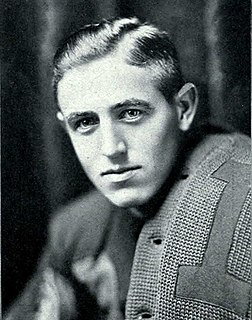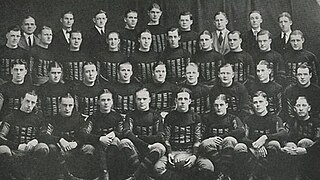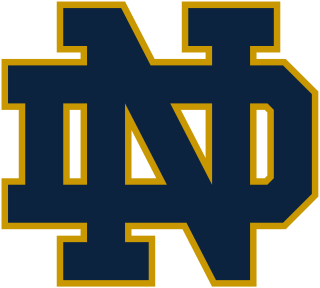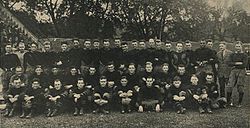
The Iowa Hawkeyes football program represents the University of Iowa in college football. The Hawkeyes compete in the West division of the Big Ten Conference. Iowa joined the Conference in 1899 and played their first Conference football season in 1900. They are a Division I Football Bowl Subdivision (FBS) member of the National Collegiate Athletic Association. The Hawkeyes play their home games in Iowa City, Iowa at Kinnick Stadium, with a capacity of 69,250. The Hawkeyes are coached by Kirk Ferentz, who is in his 24th season as the head coach and is the longest current tenured head coach in NCAA Division I FBS. Iowa has never finished a season ranked #1, though still claiming 5 National Championships.

Aubrey Alvin "Aub" Devine was an American football and basketball player, coach, and lawyer. He was the quarterback for the University of Iowa Hawkeyes football team from 1919 to 1921. He was selected as a first-team All-Big Ten Conference player all three years at Iowa and was the consensus All-American quarterback in 1921. Devine served as the head basketball coach at the University of Denver for two seasons, from 1923 to 1925. He later worked as an assistant football coach under Howard Jones at the University of Southern California (USC). Devine was inducted into the College Football Hall of Fame as a player in 1973.

Gordon C. Locke was an American football player and coach. He played college football at the University of Iowa, where he was an All-American. Locke served as the head football coach at Western Reserve University—now a part of Case Western Reserve University—from 1926 to 1930, compiling a record of 15–20–1. He was inducted into the College Football Hall of Fame as a player in 1960.
The 1939 Iowa Hawkeyes football team represented the University of Iowa in the 1939 Big Ten Conference football season. The team, nicknamed the Ironmen, was coached by Eddie Anderson and was led on the field by halfback Nile Kinnick.
The 1958 Iowa Hawkeyes football team represented the University of Iowa in the 1958 Big Ten Conference football season. The team was coached by Forest Evashevski and captained by fullback John Nocera. The Football Writers Association of America (FWAA) awarded the team the Grantland Rice Award, which is presented annually to the college football team adjudged by the FWAA to be national champion.

The 1922 Iowa Hawkeyes football team represented the University of Iowa in the 1922 Big Ten Conference football season. The team was coached by Howard Jones, was co-champion of the Big Ten Conference, and was retroactively selected as the 1922 national champion by the Billingsley Report.

The Notre Dame–USC football rivalry is an American college football rivalry between the Notre Dame Fighting Irish football team of the University of Notre Dame and USC Trojans football team of the University of Southern California, customarily played on the Saturday following Thanksgiving Day when the game is in Los Angeles or on the second or third Saturday of October when the game is in South Bend, Indiana.

The Michigan–Notre Dame football rivalry is an American college football rivalry between the Michigan Wolverines and Notre Dame Fighting Irish.
The 1956 Iowa Hawkeyes football team was an American football team that represented the University of Iowa in the 1956 Big Ten Conference football season. The Hawkeyes were champions of the Big Ten Conference and beat the Oregon State Beavers in the 1957 Rose Bowl, a rematch of a regular season game.

The 1990 Michigan Wolverines football team represented the University of Michigan in the 1990 NCAA Division I-A football season. The team's head coach was Gary Moeller. The Wolverines played their home games at Michigan Stadium. The team won the third of five consecutive Big Ten championships. They were co-champions with Michigan State, Iowa and Illinois.

The 2012 Michigan State Spartans football team represented Michigan State University in the Legends Division of the Big Ten Conference during the 2012 NCAA Division I FBS football season. Michigan State played their home games at Spartan Stadium in East Lansing, Michigan and were led by sixth-year head coach Mark Dantonio. They finished the season 7–6, 3–5 in Big Ten play to finish in fourth place in the Legends Division. They were invited to the Buffalo Wild Wings Bowl, where they defeated TCU, 17–16.
The 2015 Stanford Cardinal football team represented Stanford University in the 2015 NCAA Division I FBS football season. The Cardinal were led by fifth-year head coach David Shaw. They played their home games at Stanford Stadium and were members of the North Division of the Pac-12 Conference.
The 2015 Iowa Hawkeyes football team represented the University of Iowa in the 2015 NCAA Division I FBS football season. The Hawkeyes, led by 17th year head coach Kirk Ferentz, were members of the West Division of the Big Ten Conference and played their home games at Kinnick Stadium. Despite modest expectations entering the season, the team finished 12–2 overall and 8–0 in Big Ten play to win the West Division. After losing a classic to Michigan State in the Big Ten Championship Game, the Hawkeyes were invited to the 2016 Rose Bowl where they were beaten by Stanford. The team established a new single-season school record for wins.
The 1964 Big Ten Conference football season was the 69th season of college football played by the member schools of the Big Ten Conference and was a part of the 1964 NCAA University Division football season.
The 1949 Big Nine Conference football season was the 54th season of college football played by the member schools of the Big Nine Conference and was a part of the 1949 college football season.
The 1956 Big Ten Conference football season was the 61st season of college football played by the member schools of the Big Ten Conference and was a part of the 1956 NCAA University Division football season.
The 1921 Big Ten Conference football season was the 26th season of college football played by the member schools of the Big Ten Conference and was a part of the 1921 college football season.
The 1972 Big Ten Conference football season was the 77th season of college football played by the member schools of the Big Ten Conference and was a part of the 1972 NCAA University Division football season.
The 1975 Big Ten Conference football season was the 80th season of college football played by the member schools of the Big Ten Conference and was a part of the 1975 NCAA Division I football season.

The 2019 Michigan Wolverines football team represented the University of Michigan in the sport of college football during the 2019 NCAA Division I FBS football season. The Wolverines competed in the East Division of the Big Ten Conference and played their home games at Michigan Stadium in Ann Arbor, Michigan. Michigan was coached by Jim Harbaugh, who was in his fifth season.









